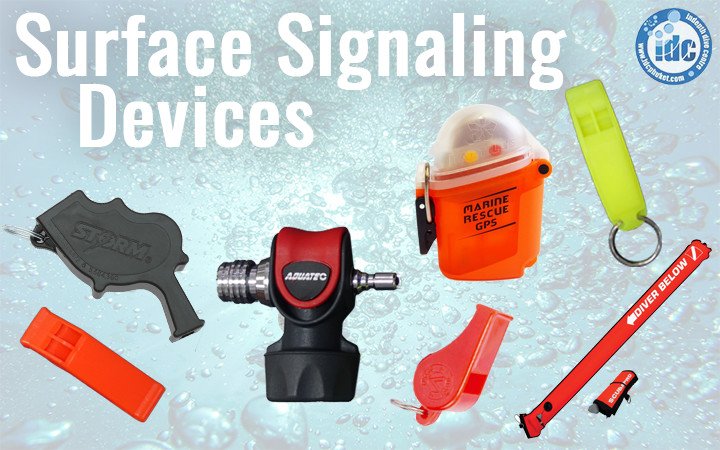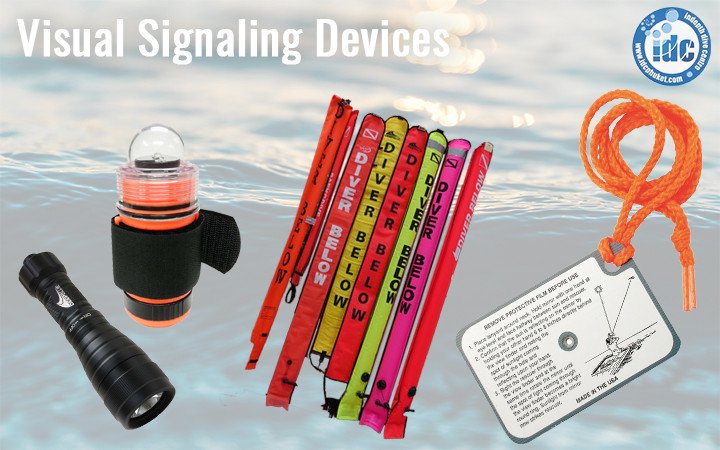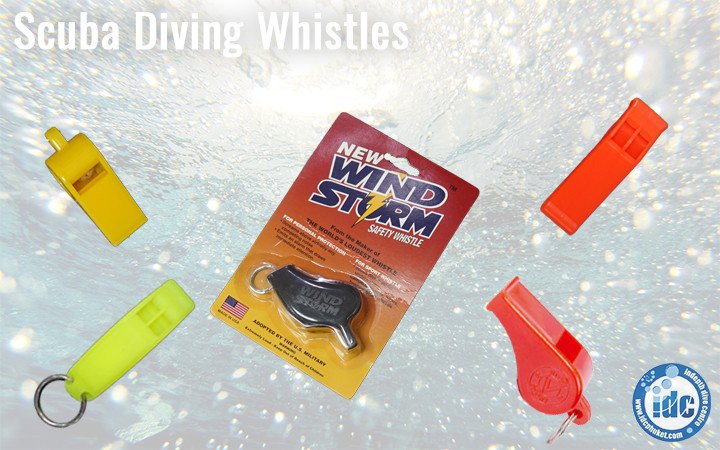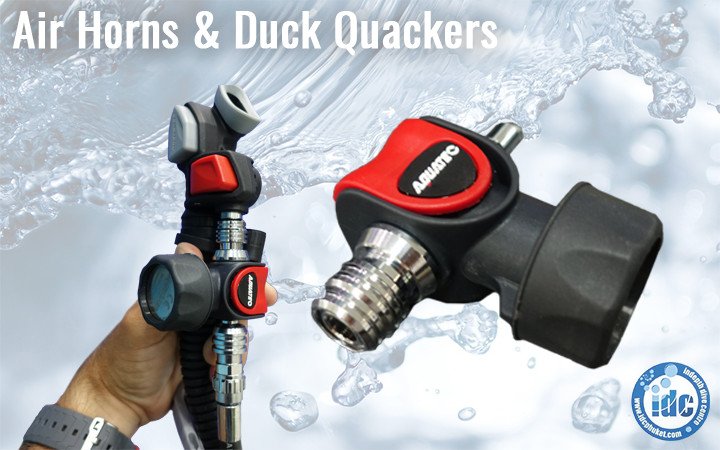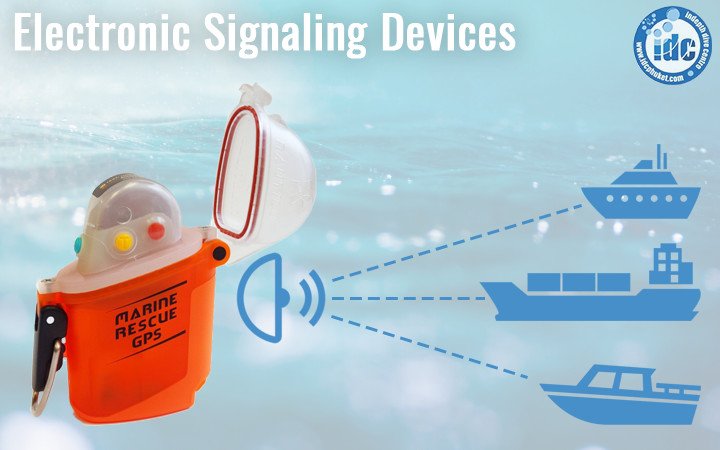Signaling Devices for Scuba Diving
The importance of scuba surface signaling devices. The open ocean is a very big place. If and when a scuba diver surfaces in the wrong location or away from the shore or from their boat, it can be difficult for others to see them against the surface of the ocean, particularly when most divers wear black wetsuits and black hoods. That’s on a good day, add in bad weather, poor visibility and big waves and divers on the surface of the ocean can be almost impossible to see. In the event of an emergency, or if the diver is simply trying to attract the attention of the boat crew to come and pick them up, they need to be able to get the attention of people either on the boat or on the shore.
Consequently, all divers should carry at least one audible and one visual signalling device with them at all times. These scuba surface signaling devices are considered standard safety equipment for all divers. In this blog, we will have a look at the different types of audible signalling devices available for divers and consider why divers need one and when one might be used. As always, this is not exhaustive so if you have a question about any piece of equipment you are using or thinking about purchasing, we are more than happy to provide advice and you can send us a message here. Likewise, if you come and dive with us, you can be guaranteed we will provide you with an audible signalling device on your rental buoyancy control device.
Missing Divers & Scuba Surface Signaling Devices
On your Rescue Diver Course, you learn techniques for searching for missing divers and for providing assistance to them once found. You learn to interview buddies to determine the last place the diver was seen and to coordinate an effective search for them within no decompression and gas limits. In the open ocean, however, the challenge of finding a missing diver becomes more difficult when you take into account the conditions and currents. Any means a missing diver has of signalling their rescuers makes the rescue a lot easier.
Visual Scuba Surface Signaling Devices
On your Open Water Diver Course you hopefully learnt how to use a visual signalling device, such as a surface marker buoy, or delayed surfaced marker buoy to attract the attention of boats or support staff from the surface. Although it is unlikely you would have used it, you also hopefully would have had attached to your equipment somewhere, usually on the low-pressure inflator some sort of audible signalling device, or a whistle. In emergency situations or when a diver is in need of assistance, they need a way of attracting the attention of boats or people on the land and an audible signalling device is one of the ways divers can do that.
As a general rule, in most situations where there is not an emergency, divers would use a visual signalling device such as a surface marker buoy, mirror or light to signal the boat or the shore to indicate they are OK or they are ready to be picked up. An audible signal device is usually reserved for emergencies where the divers need immediate assistance from the boat or shore.
Audible Scuba Surface Signaling Devices
All divers have an in-built audible signalling device when they need help; their voice. Just like all divers have a visual signalling device already in-built with their arms. However, is not easy or effective to try and project your voice over vast distances or even to try and project your voice over the noise of the waves and boat engines, it requires a lot of effort and provides limited results. This is where designated audible signalling devices readily available on the market are much more effective and useful. There are three primary options of audible signalling device available on the market; whistles, air horns and personal locator beacons.
Whistles – Scuba Surface Signalling Devices
The simplest and most affordable type of audible signalling device is the whistle. Whistles are usually made of plastic, lightweight and inexpensive. Due to their size, they can easily attach onto low-pressure inflators or D-rings on buoyancy control devices; easily within the diver’s reach.
A whistle works by channelling the air blown through it into two chambers. As the compressed air escapes through a slot in the whistle, it creates a high-pitched sound.
Due to their size and affordability, whistles are the most common audible device for divers. Whistles are also foolproof, they require no training or skill to use. They do not rely on batteries and do not need any specific maintenance in order to work. Only rinse with fresh water after each dive as for most dive equipment. Despite their simple, low-tech design, they are capable of projecting sound over the surface of the water much more effectively than a diver can project their voice.
Despite the simplicity of the whistle, there are numerous designs and styles and many have different shapes. Some whistle brands, including the Storm Whistle, can also work underwater to attract the attention of a buddy projecting a sound for more than 50 feet whilst submerged. This design forces the water inside to flow out as the diver exhales into it, making a noise underwater.
Downsides
A downside of whistles is that they often attach to BCDs with a key chain ring or zip tie. These can wear over time, causing the whistle to fall off. If this occurs, the whistle needs to be replaced.
Air Horns and “Duck Quackers”
Air horns are incredibly effective as audible signalling devices, both above and below the surface of the water. They generally attach to the diver’s first stage regulator via the low-pressure inflator hose and connect between the low-pressure inflator hose and the buoyancy control device. Models such as the Dive Alert Plus Air Horn attach this way. Its benefit is that it can connect and disconnect from any diving equipment type, brand or style easily and quickly.
DIvers operate the air horn by pressing a button which takes gas from the scuba tank and feeds it through the air horn, making a high-pitched sound. Some manufacturers claim that their horns can emit a sound that people can hear from over a mile away.
Divers can also use these devices underwater to attract the attention of a buddy. Instead of making the sound you would expect from an air horn, they make the sound of a duck! This is why they are commonly referred to as “duck quackers”. Advantages of an air horn are that it does not need batteries to work, is generally easy to operate and makes a very loud noise. As the air horn attaches to the buoyancy control device and the low-pressure inflator using the same connectors and valves as the low-pressure inflator, it may need servicing to ensure it stays in good working condition and the connection doesn’t leak as a regular low-pressure inflator connection would over time
Downsides
A downside of air horns is that they are more expensive than a standard whistle is. Also, they will only work if there is gas inside the scuba tank. In an out-of-gas emergency, the air horn becomes useless. Unlike a whistle, however, it is unlikely an air horn would fall off or be lost.
Electronic Signaling / Communication Devices
Thanks to advancements in technology, there is now a new third option for audible signalling devices for divers during emergencies. This option is to use a personal electronic locator beacon and communication device. These devices are small enough to fit inside a buoyancy control device pocket or in pocket shorts.
Upon activation, these devices emit a GPS (global positioning system) signal that relays to emergency services and can help to direct boats in the area as well as rescue personnel to your exact location. Some manufacturers state they can pinpoint your location to within 100m once the device has been activated. Some devices will emit an emergency signal letting the local boat operators, or even the Navy, know you need help. Whereas with some other systems, in addition to emitting an emergency distress signal, you may also be able to operate the device like a walkie talkie and verbally communicate with boat operators and rescue personnel via VHF radio, over the marine channel.
Some manufacturers such as Nautilus LifeLine state their beacon has a communications range of 10,400sq km. These devices can operate anywhere in the world and many have long battery life, some rated up to 5 years.
Downsides
A downside of this option of audible signalling device is that because it is electronic, it can only operate on the surface of the water. During the dive, these devices are sometimes sealed in waterproof canisters to protect them. Other models, such as the Nautilus have a housing which is rated to depths of almost 130m.
These devices are significantly more expensive than a whistle or an air horn. They also need to be properly maintained and fully charged before diving to ensure in an emergency it will work. Likewise, as this device is electronic, the firmware needs to be periodically updated so the device stays current.
Conclusions
With any type of diving you undertake, it’s vital you always carry the recommended and standard safety equipment with you. Most scuba surface signaling devices are highly affordable but may end up saving your life one day. As with any equipment purchase, we recommend you come into the dive shop and have a look at the different options yourself and see what is right for you and for your budget. If you are unable to get to us, we are still more than happy to help and you can send us any questions you have by clicking here.
More posts about diving equipment:
- Choosing Dive Equipment
- Choosing a Scuba Diving Mask
- All about snorkels
- Choosing the right fins
- Scuba Cylinders & Valves
- Buoyancy Control Devices (BCDs)
- How to choose a Scuba Regulator
- Breathing Gas Monitoring Devices
- Depth Monitoring Devices
- Scuba Diving Weights and Quick Release Weight Systems
- Choosing a wetsuit for Scuba Diving
- Choosing a Scuba Diving Compass



